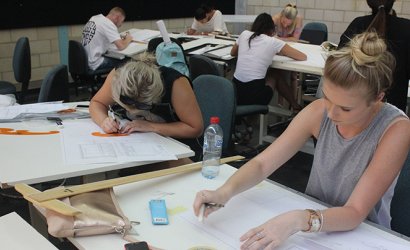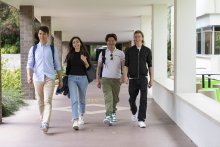

Why choose this course?
Step into the dynamic world of fashion and apparel with our Fashion Design and Production training program!
Unleash your creative potential as you gain specialized technical skills. Dive into trend forecasting and textiles to stay ahead of the fashion curve.
Develop your fashion illustration and design abilities, and bring your visions to life through specification writing, costing, and sustainable product development.
Embrace the latest technologies in pattern making, CAD grading, and virtual 3D skills, ensuring you're equipped for success in today's fast-paced fashion industry.
Join us in fashioning a sustainable future by blending style with a more conscious and responsible approach to fashion.
Training includes working with textile testing and investigation equipment, virtual and digital technology platforms, fit models for patternmaking, simulated client briefs, and presenting a fashion range in a promotional event.
Unlock a world of exciting career opportunities including roles such as Junior Designer, Pattern Maker, Garment Technologist, Virtual Technology Operator, or Fashion Business Entrepreneur.
Choose your path and embark on a fulfilling journey in the world of fashion!
Career opportunities
- Garment Technologist
- Junior Designer
- Patternmaker
-
An IELTS score (academic) of 6.0 with no band score less than 5.0 or equivalent.
-
Equivalent to Australian Year 12.
-
OR Completion of MST31022 Certificate III in Apparel, Fashion and Textiles is required for entry into this course.
There may be further semester intakes available for enrolment. You can view any further intakes when you submit your online application(opens in a new tab).
For information about pathways from TAFE to university, view our Pathways to university page.
How to apply
Apply to study at TAFE in six steps:
- find a course;
- check entry requirements;
- submit an application;
- accept your offer and pay;
- apply for your student visa; and
- receive your visa and come to Australia for your studies.
Build your own course guide
Select the study areas, courses and topics you like. Get your custom guide by email!
Download study area guide(opens in a new tab)
Contact us(opens in a new tab)
TAFE International Western Australia (TIWA) is the Registered Training Organisation (RTO) and Commonwealth Register of Institutions and Courses for Overseas Students (CRICOS) provider, for the delivery of training to international students, enrolled in a TAFE course in Western Australia. This nationally recognised course is delivered by a Western Australian TAFE college on TIWA's behalf. TIWA retains responsibility for the quality of the training and assessment delivered by the TAFE colleges and for the issue of certification documentation to students.

